Top 10 Dams in IndiaEvery living entity, without a doubt, requires water to thrive on this planet. Water is crucial for everything from survival to our everyday needs. Every country determines its own technique for water conservation and optimum utilization. Because India is an agricultural country, it requires a lot of water to keep the crops growing. Moreover, agriculture has a significant social, cultural, and political impact in addition to its economic consequence. As a result, maintaining the agricultural sector's viability necessitates several needs, one of which is the free flow of water. Also, Water scarcity or misuse of water resources affects a substantial portion of the Country's population. Many sections of the country lack sufficient clean water for consumption and irrigation. Flash floods are very frequent in many areas as well. In such a scenario, effective water storage is essential during the monsoon season to support life on drier days, and man-made dams and reservoirs play a significant role in this process of water storage and management. The Jawa Dam in Jordan, which dates back to 3,000 BC, is the oldest known dam in history. Let's learn what are dams?To put it simply, a dam is a water-conserving structure placed on rivers, tributaries, or estuaries. This concrete construction serves as a dam, stopping the movement of water and forming a storage reservoir. Modern dams are broadly divided into two types-
Types of DamsDams built by humans are stunning examples of modern architecture and civil engineering. Concrete has enormous walls and structures that are tough, sturdy, and incredibly lasting. India has a vast potential for big dam construction due to its extensive water resources and myriad rivers and has built multiple dams and water reservoirs after independence, including over 4300 large dams already in effect. Furthermore, there are additional initiatives in the works. This also attracts a considerable number of tourists throughout the year. India has around 5,200 big dams, according to the CWC (Center Water Commission), although they are not all built evenly. The leading corporations that undertake the dam construction sector in the country are Satluj Jal Vidyut Nigam (SJVN), Bharat Heavy Electricals Limited (BHEL), and National Hydroelectric Power Corporation (NHPC). To name a few of India's largest construction dams, the first Tehri Dam is the world's eighth highest dam, and Idukki is one of the first Indian arch dams erected on the Periyar River. Again, Indira Sagar Dam is also regarded as India's biggest reservoir. Earth Dams, Buttress Dams, and Gravity Dams are among the 21 varieties of dams used around the world. In India also, there are many different types of dams, so let us recognize them one by one. The various varieties are listed below, based on the structures:
Advantages of DamsLet's take a brief look at what dams can do for us now that we've learned about their significance and types:
Disadvantages of DamsDespite the advantages of dams, they also have certain drawbacks. Let's learn it right now-
List of Top 10 Dams in IndiaAgriculture forms the backbone of the Indian economy. It has a profound impact on our political, social, and cultural lives, in addition to playing an important economic function. Agriculture is heavily reliant on water. Furthermore, water is the most essential resource for any living creature to exist. During the monsoons, effective water storage is critical to sustaining life during drier days. The dams and water reservoirs in India are involved in the storage and management of water resources. While the larger dams in addition to storing water, prevent floods, generates hydroelectricity and have evolved into tourist sites that offer scenic beauty. After the United States and China, India ranks third in the world for having the largest dams. In India, there are about 4000 dams in which many of the dams are for multipurpose activities. While some of these dams were built for flood mitigation, water supply, and hydropower generation, most of them were built for providing the source of water for irrigation. So here is the list of the top 10 dams in India with a brief description of their location, features, types among other things: 1. Tehri DamTehri Dam, at 260 metres in height, is one of Asia's tallest dams and is India's highest dam. Located in the state of Uttarakhand across the Bhagirathi River, Tehri is a 2.6 cubic kilometre dam having a surface area of 52 square kilometres and a length of 575 metres, a crest width of 20 metres, and a base width of 1,128 metres. 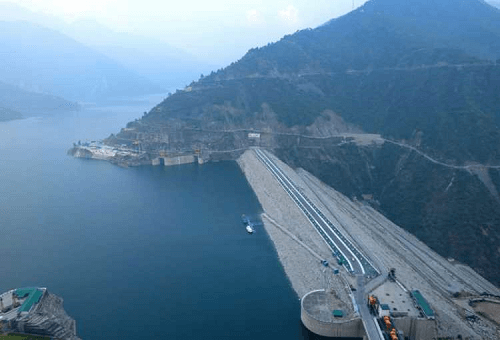
Tehri Dam gets its water from the Bhagirathi and Bhilangana rivers in the Himalayas. This dam is India's major hydroelectric water project. The dam produces 1,000 MW of hydroelectricity in addition to delivering water for cultivation and everyday demand. As per the Tehri Dam Project, it has the capacity to provide water to about 40 lakh people in Delhi and another 30 lakh people in Uttar Pradesh. It does not just supply power for the entire state of Uttarakhand, but it is also a vital resource for the fishing and tourism industries. In a nutshell, the Tehri dam is a blessing to Uttarakhand inhabitants, as it creates a great number of job opportunities. The idea of Tehri was devised in 1961, and the endeavour to make it a reality began in 1978. Despite objections to the dam's construction due to potential environmental concerns and developmental delays due to a lack of funding, the dam was finally completed in 2006 with the assistance of the USSR, which helped overcome financial challenges. Main features:Height: 260 m Length: 575 m Type: Rockfill dam Built across: Bhagirathi River Located in: Uttarakhand Storage Capacity: 2,00,000 acre-feet Installed Capacity: 1000 MW (Megawatt) 2. Bhakra Nangal DamErected across the Sutlej River, which flows through the North Indian states of Punjab and Himachal Pradesh, Bhakra Nangal dam is one of the largest dams in India. This dam is the first river valley development project undertaken by the government after independence. 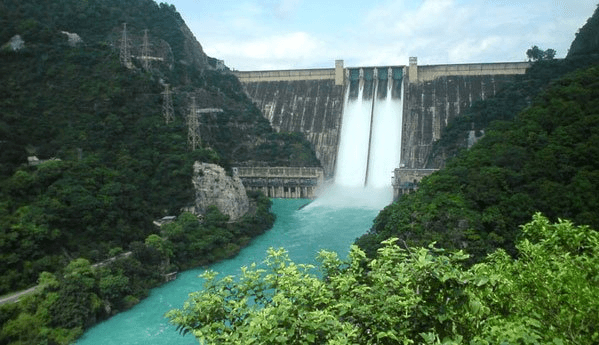
Situated in the Bilaspur district of Himachal Pradesh, it is the Asian continent's second-largest dam. With a height of 226 metres and a length of 520 metres, this massive dam is a sight to behold. The reservoir at Bhakra Nangal, known as 'Gobind Sagar,' can hold up to 9.34 billion cubic metres of water and has India's second-largest reservoir volume capacity. This dam covers an area of roughly 7,501,775 acres and has the potential of producing 1,375 megawatts of electricity in its reservoir. The dam, which has ten power generators along either side, shields the farms from monsoon damage. Nangal Dam is a separate dam in close vicinity to Bhakra Dam. Although they are two independent dams, they are referred to as Bhakra-Nangal Dam. This dam's huge reservoir is home to an abundance of aquatic life, making it a regular source of income for local fishermen. Aside from energy production and fishing, this reservoir's water is used for agriculture in the states of Punjab, Haryana, and Rajasthan. Tourists used to come from all across India to see this dam because of its tremendous height and stunning landscape. However, in 2009, due to security concerns, it was unfortunately closed to the public. Features:Height: 226 m Length: 520 m Type: Concrete Gravity dam Built across: Satluj River Located in: Himachal Pradesh Storage Capacity: 7,501,775 acre-feet Installed Capacity: 1375 MW (Megawatt) 3. Sardar Sarovar DamThe Sardar Sarovar dam is built on the Narmada River in the Narmada district of the state of Gujarat. Its construction started in 1979. It is one of the world's largest dams in terms of both volume and size. It stands at a height of 138.6 metres and has a length of 1210 metres. 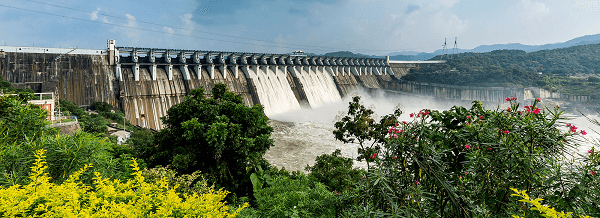
India's first deputy prime minister, Sardar Vallabhbhai Patel, is credited with the vision of this dam, and on April 5, 1961, Indian Prime Minister Pandit Jawaharlal Nehru laid the foundation stone for this project. Sarovar Dam, which is part of the Narmada Valley Project and serves as a multi-purpose dam, is the largest structure to be constructed across the Narmada River. The dam is primarily intended to provide the people of Gujarat with drinking and irrigation water, and hydropower. It is crucial in supplying water to the dry districts of Kutch and Saurashtra, which are frequently subjected to harsh and recurrent droughts. With a reservoir capacity of 7,701,775 acres and the electricity generation capacity of up to 1450 MW, this dam provides water for irrigation and energy not only to Gujarat, but to other states like Rajasthan, Madhya Pradesh, and Maharashtra as well. Prime Minister Narendra Modi opened the dam in 2017. This dam is a boon to drought-stricken areas along with providing transportation amenities throughout the region. Further, the dam has also become a popular tourist destination due to its natural beauty and tourist attractions. The Gujarat state government also intends to install solar panels in the Narmada canal to produce solar energy, which will benefit Gujarat's villages. Features:Height: 138.6 m Length: 1210 m Type: Concrete Gravity dam Built across: Narmada River Located in: Gujarat Storage Capacity: 7,701,775 acre-feet Installed Capacity: 1450 MW (Megawatt) 4. Hirakud Dam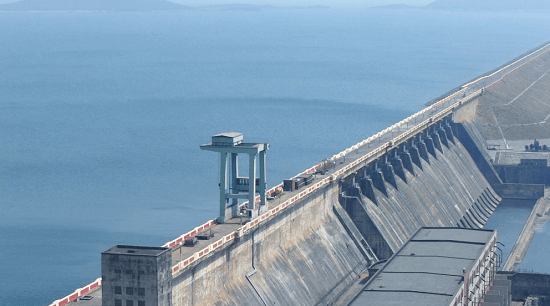
Hirakud Dam is one of the world's longest dams, erected on the Mahanadi River in Odisha. This dam was constructed in 1957 and is known for being the first multi-functional dam built in India after independence. It has a height of 60.96 metres and a length of 61 metres, with a 743-square-kilometre artificial lake that is Asia's largest artificial lake and is itself the world's longest human-made earthen dam. The dam has a reservoir capacity of 4,779,965 acres and serves as a flood control system for the Mahanadi delta's surrounding territories. It produces 347.5 megawatts of power, which is supplied throughout adjacent areas across the Mahanadi River basin. The Hirakud Reservoir, the dam's lake, is a popular tourist destination that is enhanced by a big flock of migratory birds throughout the winter months. As a result, tourists may see the captivating breath-taking views and wildlife that surrounds it. The interesting aspect about this dam is that it is built between two hills, making it a must-see destination for tourists from all over the world. It's not only a gorgeous site to visit, but it's also a great setting for wildlife to dwell in. Scuba diving was used to examine the waters of Hirakud after several historic temples were unearthed during the dam's construction. These temples can be visited by boat in May and June. Features:Height: 60.96 m Length: 61 m Type: Composite dam and reservoir Built Across: Mahanadi River Located in: Odisha Storage Capacity: 4716736.4 acre-feet Installed Capacity: 347.5 MW (Megawatt) 5. Nagarjuna Sagar Dam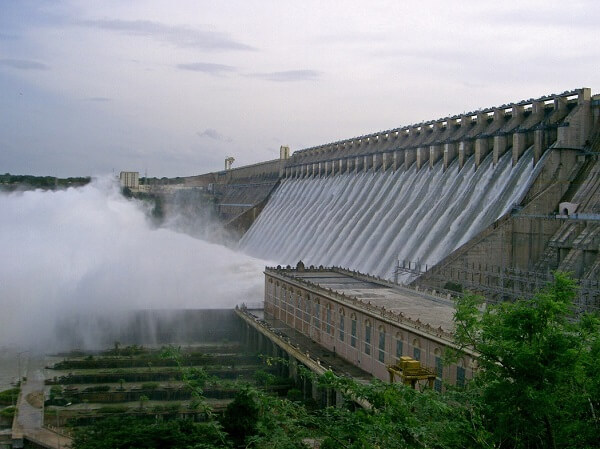
The Nagarjuna Sagar Dam, the world's largest masonry dam, is located on the great Krishna River in the state of Andhra Pradesh. The dam, which has 26 gates and was built between 1955 and 1967, was opened by Jawaharlal Nehru and has a height of 124 metres and a length of 1550 metres. It has a reservoir capacity of 11, 472 million cubic metres, making it India's second-largest reservoir. It is one of India's oldest and largest multi-purpose and hydropower dam projects. The dam is named after a Buddhist monk called Acharya Nagarjuna. Nagarjuna Sagar irrigates more than 10 lakh acres in the districts of Nalgonda, Guntur, Khammam, and Prakasam. It generates 816 MW of electricity for the entire Krishna River basin. This dam provides water and electricity to districts such as Nalgonda, Guntur, Krishna, Suryapet, and other sections of West Godavari. The dam is noted for its massive size, mind-boggling architecture, and technological achievements. It is encircled by rich flora, making it a popular tourist destination. The reservoir, which is close to the dam, is a beautiful spot. Aside from it, there are attractions such as Nagarjunakonda Island, which is located in the lake's heart. As a result, it is a popular monsoon weekend escape for inhabitants of Hyderabad and the surrounding districts. Features:Height: 124 m Length: 1550 m Type: Masonry dam Built across: Krishna River Located in: Andhra Pradesh Storage Capacity: 11.472 billion cubic metres Installed capacity: 816 MW (Megawatt) 6. Mettur DamThe Mettur Dam spans the Kaveri River, which runs through Tamil Nadu. Situated in the district of Salem, it is one of India's largest dams, as well as the largest in the state of Tamil Nadu. Constructed in 1934, this dam is also one of India's oldest. 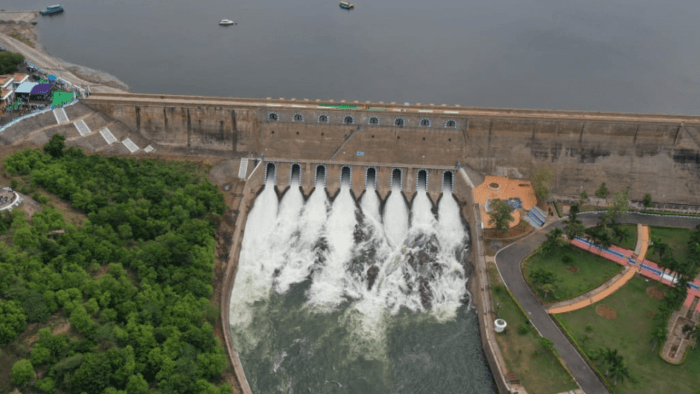
It stands 65 metres tall and has a length of 1,700 metres. It is the principal source of living for more than 12 districts in Tamil Nadu, providing water for irrigation and drinking. The most essential function of this dam is that it has the country's largest power generating capability. It has a capacity of 200 MW installed. There is a park called Ellis Park at the base of this dam. The Park, as well as the massive hydroelectric power stations that surround this dam and the hills on all sides, make it one of the top tourist destinations in India for its natural visual splendour. Features: Height: 65 m Length: 1700 m Type: Gravity, Masonry dam Built across: Kaveri River Located in: Tamil Nadu Storage Capacity: 2,146,071 acre-feet Installed capacity: 200 MW (Megawatt) 7. Indira Sagar DamIndira Sagar Dam is a 92-meter-high and 653-meter-long structure built across the Narmada River in Madhya Pradesh. It is a concrete gravity dam that plays a critical role in resolving the area's water shortages. Madhya Pradesh irrigation and the National Hydroelectric Power Corporation collaborated to build the dam. Indira Gandhi, the erstwhile Prime Minister of India, opened it in 1983. 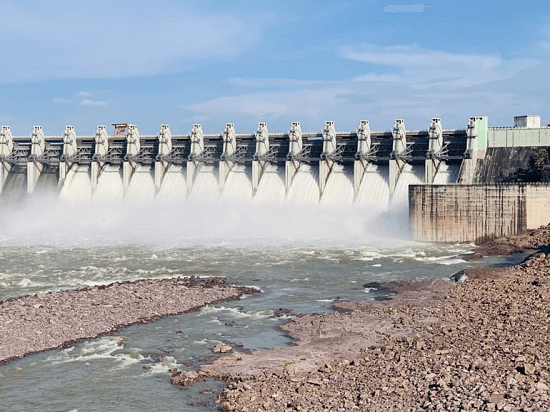
One of the main advantages of this dam is its incredible water storage capacity and potential to provide irrigation to vast farmlands. This dam has a reservoir capacity of 9,890,701 acres. Hence, among all the dams in India, the dam is known for having the largest reservoir. It has a 1000 MW installed capacity and produces 1000 MW of energy for locations such as Narmada Nagar, Mundi in the Khandwa district, and other Madhya Pradesh regions. Features:Height: 92 m Length: 653 m Type: Concrete Gravity dam Built across: Kaveri River Located in: Tamil Nadu Storage Capacity: 9,890,701 acre-feet Installed capacity: 1000 MW (Megawatt) 8. Krishna Sagar DamThe Krishnarajasagar dam, built across the river Kaveri in Mysore, Karnataka, is located in the state of Karnataka. Constructed in 1938, it is one of the greatest dams in South India, with a height of 39.8 metres and a length of 2620 metres. Despite the state's dire financial situation, Krishna Raja Wadiyar IV Maharaj of Mysore built the dam amid a famine. He was the inspiration for the dam's name. 
The dam has a reservoir capacity of 1,109,742 acres, and its water is used for irrigation in Mysore Mandya and other regions of Karnataka. It serves as the principal source of drinking water for the cities of Mysore, Mandya, and Bangalore, Karnataka's largest metropolitan city. Not only is the structure famous for its ability to generate large amounts of hydroelectricity and irrigation water, but it also houses the Brindavan Gardens, one of India's most popular tourist attractions. One of the main draws is the huge variety of indigenous and migrating birds. Around 220 bird species have been documented in substantial numbers here in the past couple of years. It is because of this characteristic, that this dam is one of the greatest tourist destinations in the state, particularly for birdwatchers. Features:Height: 39.8 m Length: 2620 m Type: Gravity dam Built across: Kaveri River Located in: Karnataka Storage Capacity: 100,870 acre-feet 9. Rihand DamThe Govind Ballabh Pant Sagar Dam, commonly known as Rihand Dam, is situated near Pipri village in Uttar Pradesh's Sonbhadra district. It is the state of Uttar Pradesh's largest multifunctional project. This is India's largest man-made reservoir/lake, as well as the country's largest dam by volume. 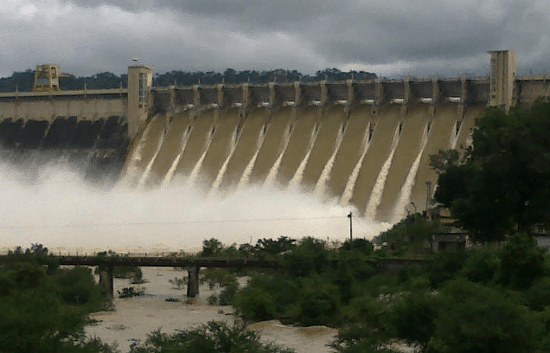
The dam is erected on the Rihand River, a tributary of the Son River, and spans the Govind Ballabh Pant Sagar Lake reservoir. The name of the lake is dedicated to liberation hero and modern architect Bharat Ratna Pandit Govind Ballabh Pant. The building of the 91.44 m high and 934.21 m long concrete gravity dam began in 1954 and was finished in 1962. There are 61 joint and independent blocks in the dam. The water from the dam is discharged into the Rihand river throughout the year to irrigate the state's agricultural land. The UP Hydroelectricity Corporation Ltd manages a hydroelectric power-producing plant that generates 300 megawatts of electricity. The dam's catchment area is home to several super thermal power plants. Singrauli, Vindyachal, Rihand, Anpara, and Sasan super thermal power stations, as well as Renukoot thermal power stations, are among them. The splendour of the landscape and the grandeur of the water body will undoubtedly captivate visitors. It has a spectacular view and is an excellent destination for nature lovers to relax and unwind. Features:Height: 91.44 m Length: 934.21 m Type: Concrete Gravity dam Built across: Son River Located in: Uttar Pradesh Storage Capacity: 10.6 billion cubic metre Installed capacity: 300 MW (Megawatt) 10. Koyna DamMaharashtra is noted for having some of India's largest dams. And with a height of 103 metres, Koyna Dam is one of the state's major infrastructure projects. It is one of the most significant civil engineering works undertaken in India since independence. It's a rubble-concrete dam built on the Koyna River, which flows through Mahabaleshwar, a hill station in the Sahyadri hills. It is on the state route between Chiplun and Karad in Koynanagar, Satara district, in the Western Ghats. The dam is situated between Koyna Sanctuary and Chandoli National Park and is surrounded by steep topography. 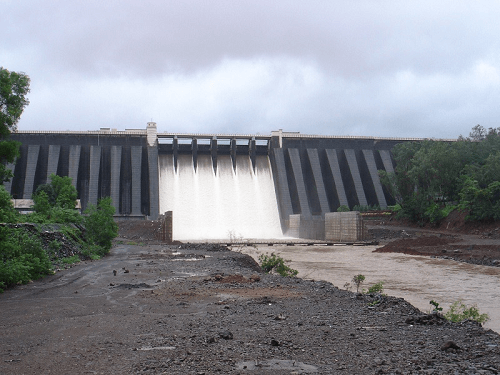
The dam's work started in 1956 and was completed in 1964. It is India's second-largest finished hydropower project. The Tata group constructed a hydroelectric facility on the Koyna River after World War I. This dam has previously been subjected to earthquakes, causing some cracks to develop, but it has since been repaired and is regarded to be sturdy enough to withstand future tectonic activity. It is utilised to generate hydroelectricity and to provide irrigation to neighbouring states. It provides both water and hydroelectric electricity to Paschim Maharashtra. With a total installed capacity of 1,920 MW, the Koyna Hydroelectric Project is India's largest completed hydroelectric power facility. During the monsoon season, the dam is critical for flood management. Features:Height: 103 m Length: 807.22 m Type: Rubble-concrete dam Built across: Koyna River Located in: Maharashtra Storage Capacity: 2,267,900 acre-feet Installed capacity: 1,920 MW (Megawatt)
Next TopicTop 10 Engineering Colleges in the World
|
 For Videos Join Our Youtube Channel: Join Now
For Videos Join Our Youtube Channel: Join Now
Feedback
- Send your Feedback to [email protected]
Help Others, Please Share









